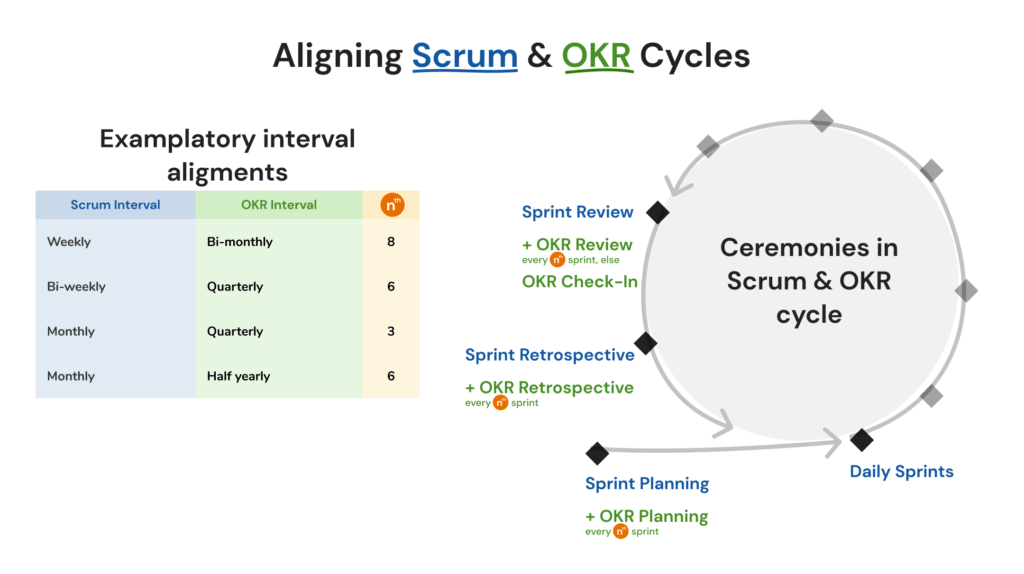Both Scrum and OKR are currently very popular as frameworks in the agile community. Scrum comes more from the world of software development, OKRs more from strategy. But can these methods also be combined and used in an integrated manner? Does “OKR vs. Agile using Scrum” go together?
That's fine! Here you can find out what is important:
Understand the goals of Scrum & OKR – are both agile?
Before we start with the implementation, we should answer an important question: Do Scrum and OKRs actually fit together in terms of their objectives?
Let's check it out together.
The specific goals of a Scrum implementation in each organization can of course vary in focus. In principle, however, one can say that the goals of Scrum are derived from the Scrum Guide derive and above all include the following points:
- Developing solutions to complex problems
- Quick adaptation to new findings through transparency and spaces for reflection and personal responsibility
- An iterative approach with useful increments
OKRs mainly focus on the following goals:
- Consistent understanding and focus on the key priorities of an organization
- Create measurable objectives within an organization
- Improvement of the cross-functional communication and alignment of an organization
Scrum is primarily aimed at working on a product within teams, while OKRs are about cross-team transparency and strategic alignment. We can thus state that the objectives of OKRs and Scrum are different, but not contrary. Rather, OKR and Scrum complement each other in their objectives.
Now let's get to practice:
Scrum and OKR share comparable agile workshop formats
If we take a look at the Scrum and OKR cycles with their workshops in comparison, the overlaps become clear:
|
Scrum cycle & workshops |
OKR cycle & workshops |
|
Sprint planning |
ORK Planning |
|
Dailies |
OKR check-ins |
|
Sprint review |
OKR review |
|
Sprint retrospective |
OKR retrospective |
💡 If you have any questions about the individual OKR workshops, please have a look at this blog article .
Grow Your Teams Using Cutting-Edge Research!
- 80+ page eBook introducing a powerful model based on the research of Dr. Jef van den Hout and many more scientists
- With 12 team workshops to get your team into a continuous positive flow
This overlap is no coincidence as both Scrum and OKRs are based on the classic Deming circle Set up the model: Plan – Implement – Check – Act. So it's much less “Agile vs OKR”, but “Agile & OKR”.
So how can these agile workshops / formats be brought together?
Align Scrum Sprints and OKR Cycles
The OKR workshops do not necessarily have to mean new, separate dates in the calendars of the Scrum teams. Depending on how the teams work, the OKR workshops can be incorporated into existing routines. A Scrum team, for example, has a number of thematically overlapping dates on which the OKR workshops can be docked.
It should be noted that the Scrum cycle usually does not match the OKR cycle. The OKR cycles are often longer quarterly to half-yearly, while Scrum Sprints tend to take place weekly to monthly.
The cycles should therefore be coordinated in such a way that a new OKR cycle is initiated in every umpteenth Scrum cycle:

- Sprint planning → incl. OKR planning every n-th time
- Sprint review → incl. OKR review every n-th time, otherwise incl. OKR check-in
- Sprint Retro → incl. OKR Retro every n-th time
Scrum and OKR So despite their different backgrounds and time horizons, they can very well be combined as agile working methods. In order for this link to work properly, however, further coordination between the two frameworks is required:
Coordination of Scrum's sprint goals with OKRs
An important factor in the selection of the rhythm is that the Scrum team works across the Scrum cycles, at least thematically, on the same value levers that are also taken up in the OKR cycle.
If the sprint topics change to completely different value levers within an OKR cycle, which were not taken into account in the OKR, one should tend to choose a shorter OKR cycle.
A look at the product roadmap can therefore help to define suitable OKRs that are suitable for measuring success across all sprints.
| Example: Good sprint & OKR coordination | Example: Bad sprint & OKR coordination |
In accordance with the product roadmap, the Scrum team will work on various features in the next quarter to carry out credit checks more quickly. The team's OKR therefore provides various metrics to handle this goal. In each sprint of the quarter, different topics are focused that contribute to the OKR. | The product roadmap provides for various UX improvements to be implemented in the next quarter. The team decides to define the speed of registration of new users as a key result. Optimization of the register is already completed after three weeks and the team is devoting itself to other UX improvements that are no longer related to the key result. |
| ✅ The sprint topics contribute to the defined key results over the entire OKR cycle. | ❌ The sprint topics no longer contribute to a current key result. |
As soon as the sprint goals deviate from the OKRs, one should think about either shortening the OKR cycle or including new key results within the OKR cycle that reflect the actual sprint topics.
Conclusion: Agile working with OKR & Scrum – is even better together
As we have found, the objectives of OKRs and Scrum are different but compatible. Both Scrum and OKR follow the agile principles through their iterative, evidence-based approach. One can even say that both frameworks complement each other to a certain extent.
With a few good preliminary considerations, OKRs can be combined with Scrum in practice in order to use the advantages of both frameworks in agile work. You don't have to overwhelm teams with new series of appointments, you can also cleverly integrate the formats.
Of course, a combination of Scrum and OKR will not be a sure-fire success. As always, the implementation requires several iterations and a good reflection process. There are probably many more traps that only emerge in practice. So I recommend you read here how you can OKR retrospectives which generate targeted reflections on the success factors of OKRs to continuously develop your custom OKR implementation.
Do you have any experience with Scrum and OKRs that you would like to share? Or have questions about the integration of the two frameworks that remained open? Then feel welcome to connect with me and Echometer on LinkedIn let's discuss!
Final tip: OKR & Scrum with Echometer
In order to continuously develop Scrum & OKRs in the team (and beyond), a look at Echometer could be worthwhile. In Echometer you will receive suggestions for suitable food for thought for your retros.
With the psychological models in Echometer, you can measurably further develop the team and corporate culture as a whole in addition to OKR and Scrum.
Learn how team and organizational development with Echometer works now!
Credits
Photo of Tachina Lee on Unsplash









